Ranked: America’s most beautiful city parks
Gorgeous green spaces
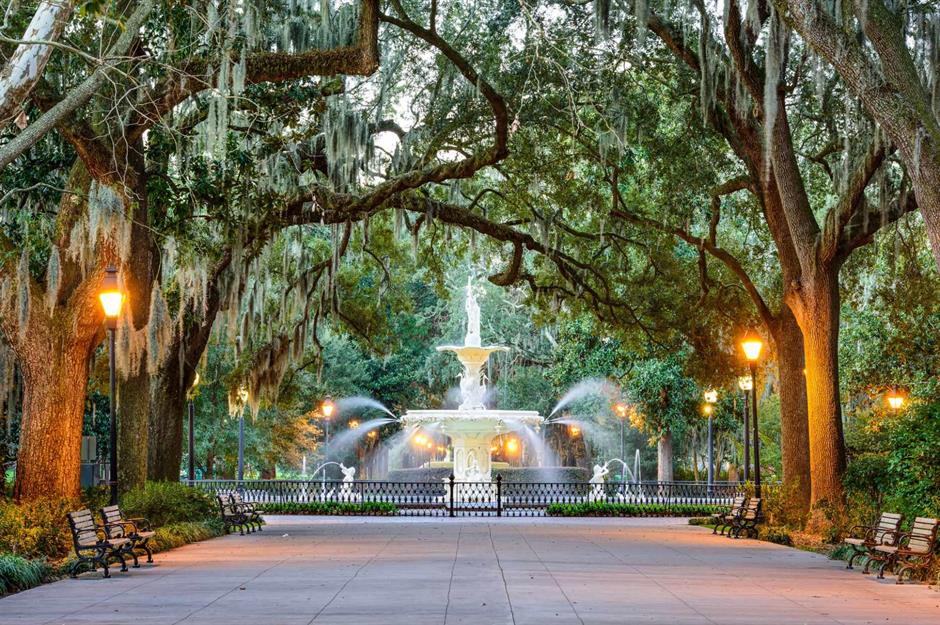
City parks are a much-needed break from bustling metropolises, providing space for walking, jogging, playing sports, socializing, or simply spending time outdoors whatever the weather. You might be surprised to learn, then, that these green oases only really began to be a major feature of American cities in the mid-19th century, with early examples like the iconic Central Park laying the groundwork. We've rounded up and ranked what we think are the most beautiful urban parks from across the United States.
Click through this gallery to see which gorgeous city park took our number one spot...
30. Discovery Park, Seattle, Washington
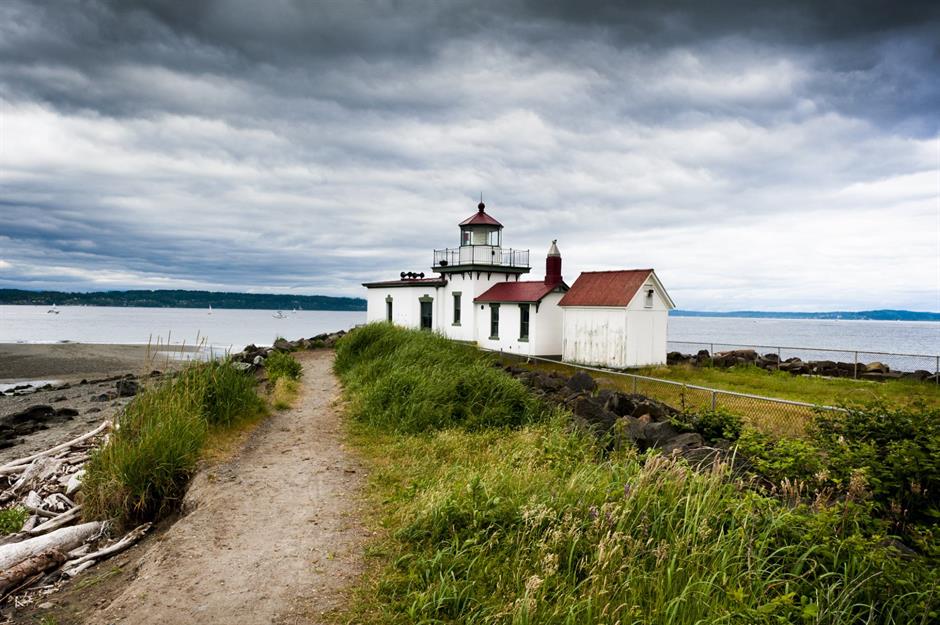
With 534 acres of wild meadows, forests, and craggy cliffs, there’s plenty to discover in this aptly-named park. Seattle’s Discovery Park, situated on Magnolia Bluff looking out across Puget Sound, offers visitors a good dose of windswept Pacific charm which feels a world away from the crowds of Pike Place Market. As well as containing 12 miles of walking trails, the space is home to historic gems including the 19th-century West Point Lighthouse (pictured) and the remains of former US army outpost Fort Lawton.
29. Audubon Park, New Orleans, Louisiana
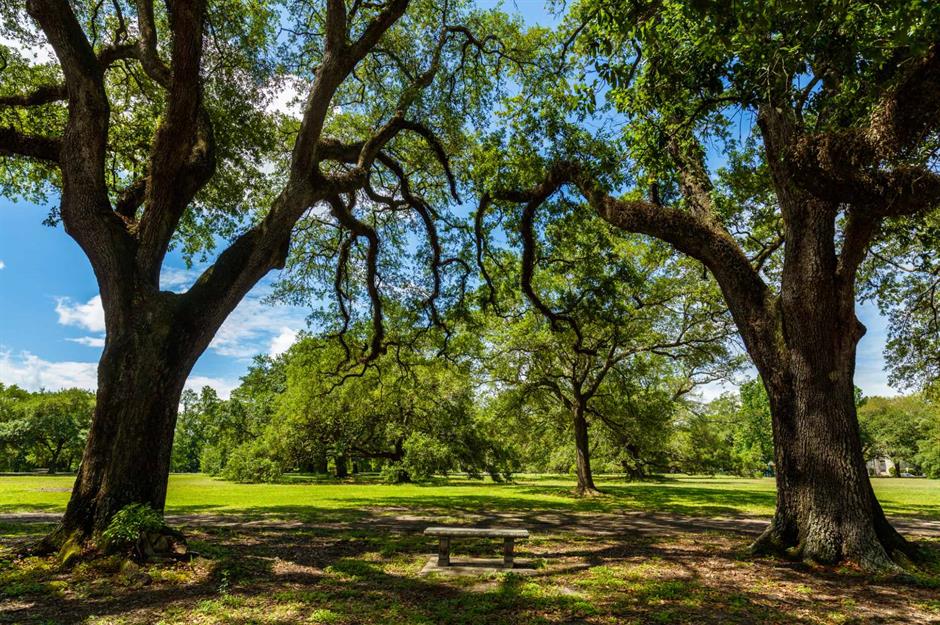
Located minutes away from downtown New Orleans, Audubon Park’s oak-fringed pathways and wide grassy expanses are perfect for laid-back strolling. It’s named after John James Audubon, a naturalist and artist best known for his bird paintings, who lived in New Orleans in the 1820s and 1830s – the city zoo (situated in the park), the aquarium, and several streets also bear his name.
However, Audubon’s legacy has a dark side which mustn’t be forgotten. As stated by the National Audubon Society, he was a slave owner who dismissed the abolitionist movement and held white supremacist views.
28. Encanto Park, Phoenix, Arizona

Built in the 1930s, the 222-acre Encanto Park was the brainchild of wealthy philanthropist William G Hartranft, who wanted to create a green space in the image of San Diego’s Balboa Park and San Francisco’s Golden Gate Park. It has a little something for all the family: there’s a historic clubhouse and boathouse, a children’s amusement park called Enchanted Island, and an 18-hole golf course.
Love this? Follow us on Facebook for travel inspiration and more
27. Norman B Leventhal Park, Boston, Massachusetts
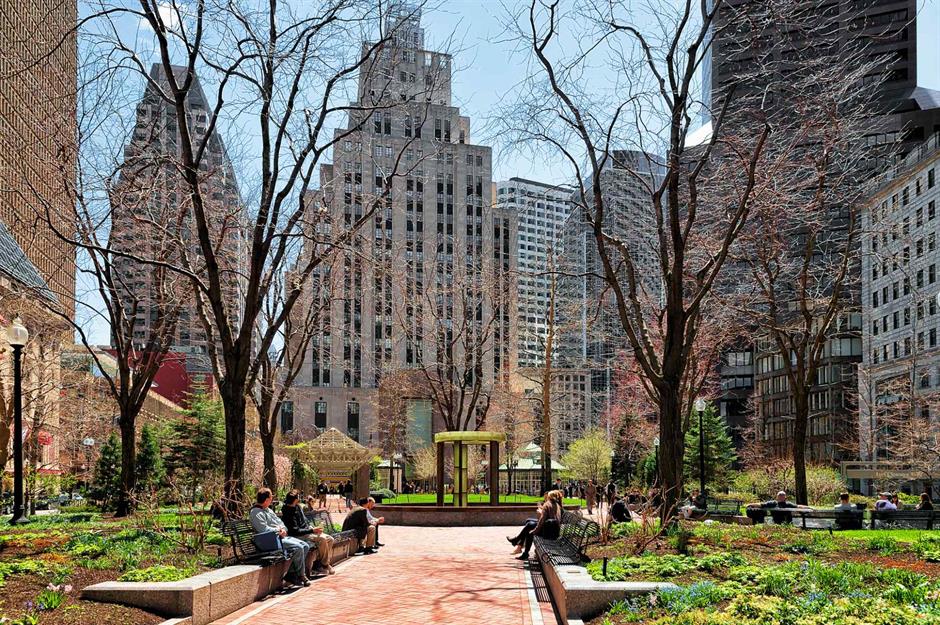
This pocket-sized patch of greenery measures just 1.7 acres. Don’t be fooled by the small size, though, as it has an intriguing and multifaceted history.
It's situated in Post Office Square in Boston’s modern-day financial district, and since the 18th century this square has served as a maritime district, an affluent residential area, a slum, and a parking garage. In fact, it wasn’t until 1992 that the park was completed. Today, it’s home to more than 125 different types of plant, from spring blossoms to bright summer flowers.
26. Governors Island, New York City, New York

Snuggled between Lower Manhattan and Brooklyn, this 172-acre island is the perfect adult playground for hiking, cycling, picnicking, and more. Governors Island was initially used as a fishing ground for Indigenous Lenape people, before serving as a military base during the Revolutionary War (1775-1783) and a Union outpost during the Civil War.
Today, its well-preserved buildings offer a glimpse into this history. They include Fort Jay, which was occupied by the British during the revolution and rebuilt in 1809, the 19th-century Castle Williams, and Colonel's Row, a collection of former army officers' quarters.
25. Fairmount Park, Philadelphia, Pennsylvania
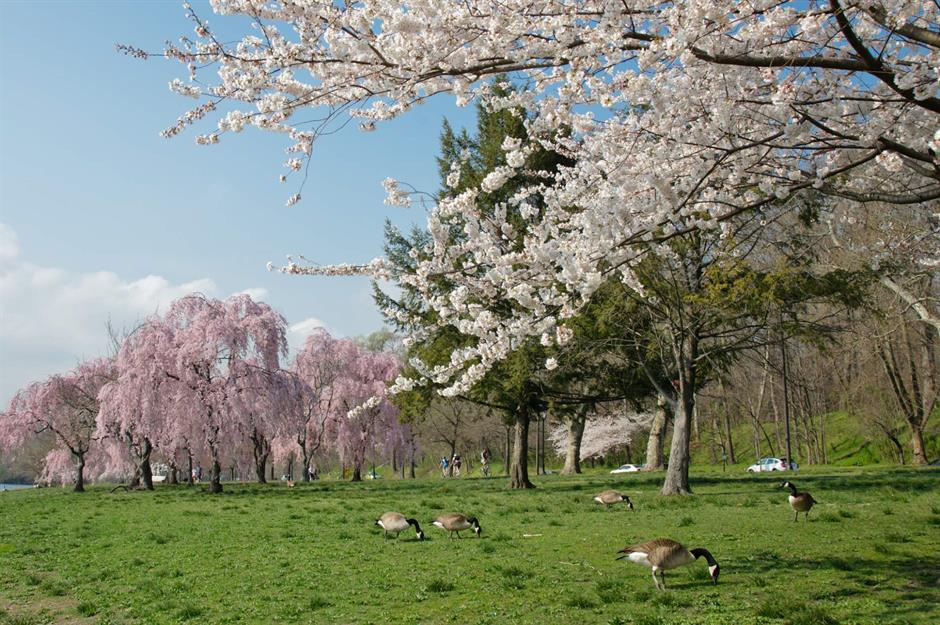
The 2,054-acre Fairmount Park is so enormous it’s almost a city within a city. As well as being home to plenty of trails, America’s oldest zoo, and historic 18th-century houses, one of its prettiest attractions is the Shofuso Japanese House and Garden.
The traditional-style Japanese house, overlooking the Schuylkill River, was built in Japan in 1953 and shipped to the US as a gift to celebrate the two countries’ post-war relationship. Today, it hosts Philadelphia’s Cherry Blossom Festival each spring, when Fairmount's grounds become enveloped in cotton-candy hues.
24. Klyde Warren Park, Dallas, Texas

Since opening in 2012, this new addition to downtown Dallas has quickly become a community hub. Constructed over the recessed Woodall Rodgers Freeway, the 5.4-acre park hosts some of the city’s top events, including live concerts, outdoor movie screenings, educational events, and an array of exercise classes. A long-awaited expansion is set to see the park gain another 1.7 acres.
23. Meridian Hill Park, Washington DC

Officially called Meridian Hill Park, this northwest DC public garden is known to locals as Malcolm X Park – a name coined after Angela Y Davis made a speech here in 1969, calling for it to become a symbol of Black pride. Its most recognizable feature is its 19th-century mansion on Meridian Hill, complete with a Beaux Arts-style fountain which cascades over 13 levels into the tranquil Reflecting Pool. Sadly, the fountain has been switched off for several years as it awaits much-needed repairs.
22. Pappajohn Sculpture Park, Des Moines, Iowa
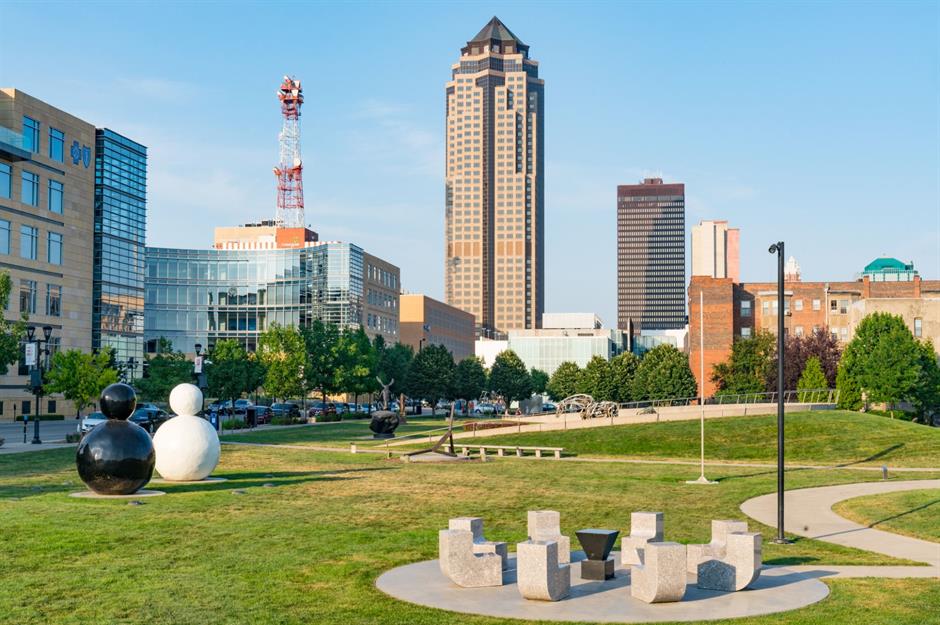
It’s not often that a park doubles up as an outdoor gallery. Which is exactly why Des Moines’ Pappajohn Sculpture Park, filled with 28 acclaimed statues by world-renowned artists, is so special.
It all started in 2007, when venture capitalist and art enthusiast John Pappajohn offered to donate sculptures he’d collected with his wife, Mary, to be displayed in a 4.4-acre patch of land the city had recently acquired. The park was opened two years later. It’s laid out like a gallery, with the sculptures progressing from realist works at the eastern end, to more abstract and conceptual structures at the western end.
21. Romare Bearden Park, Charlotte, North Carolina
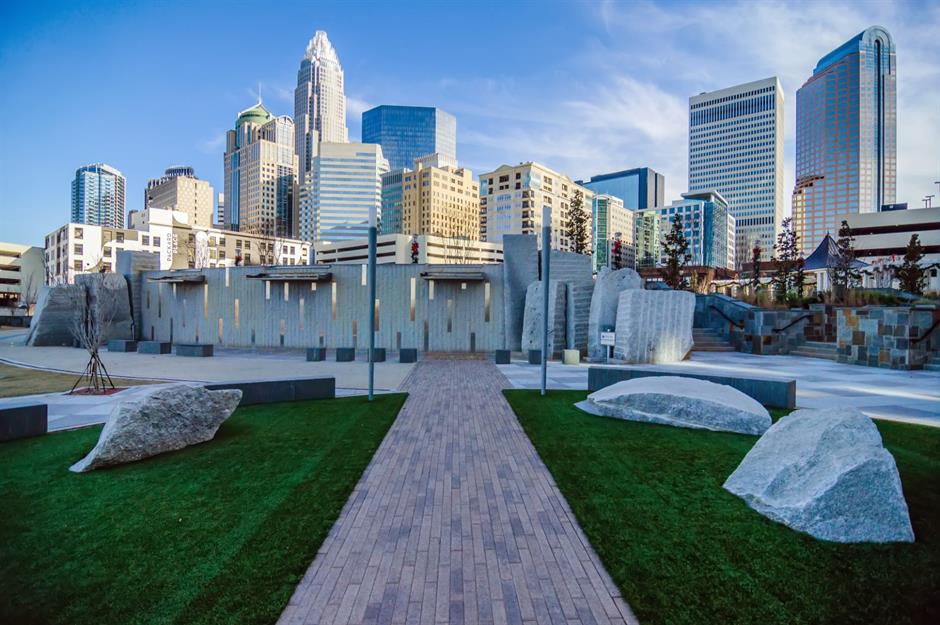
This compact 5.4-acre city park gets its name from Romare Bearden, a Charlotte-born African American artist. Created in 2013 by landscape design firm Neighboring Concepts, the modern space includes an arbor trellis which is supposed to evoke similar structures in Parisian parks – an homage to Bearden’s education at the Sorbonne. There’s also a striking multi-level fountain and several seating areas, which provide unbeatable views of uptown Charlotte’s skyline.
20. Prospect Park, New York City, New York
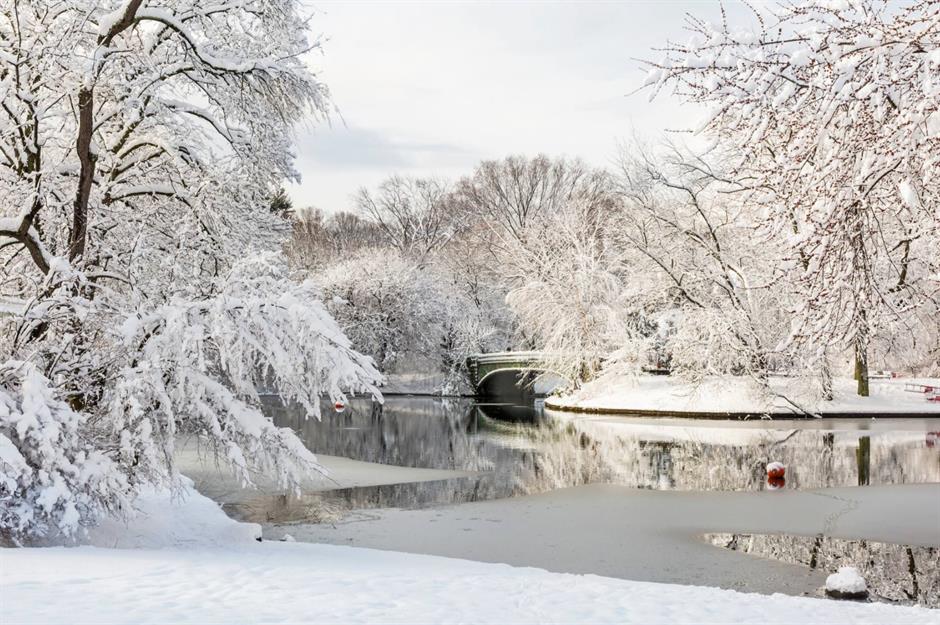
Another creation by Calvert Vaux and Frederick Law Olmsted, the duo best known for Central Park, Prospect Park is Brooklyn’s answer to the Manhattan icon. While it may not have quite the same level of fame, the 526-acre grounds have plenty of bells and whistles of their own: there’s an intricate maze of man-made lakes, the renowned Botanic Garden, rustic 19th-century arches, and even a small zoo.
Meanwhile, if it’s old-school picnicking and sunbathing you’re after, the wide expanses of Long Meadow are the perfect spot.
19. Lincoln Park, Chicago, Illinois

The largest park in Chicago, Lincoln Park encompasses 1,208 acres of attractive, landscaped grounds. It’s home to one of the only remaining free zoos in the country, the Lincoln Park Zoo, as well as the Lincoln Park Conservatory, a Victorian-era glasshouse showcasing a stunning array of plants from all over the world. It’s situated in an upscale neighborhood which shares its name, whose residents are lucky to count the space as their backyard.
18. Grant Park, Chicago, Illinois
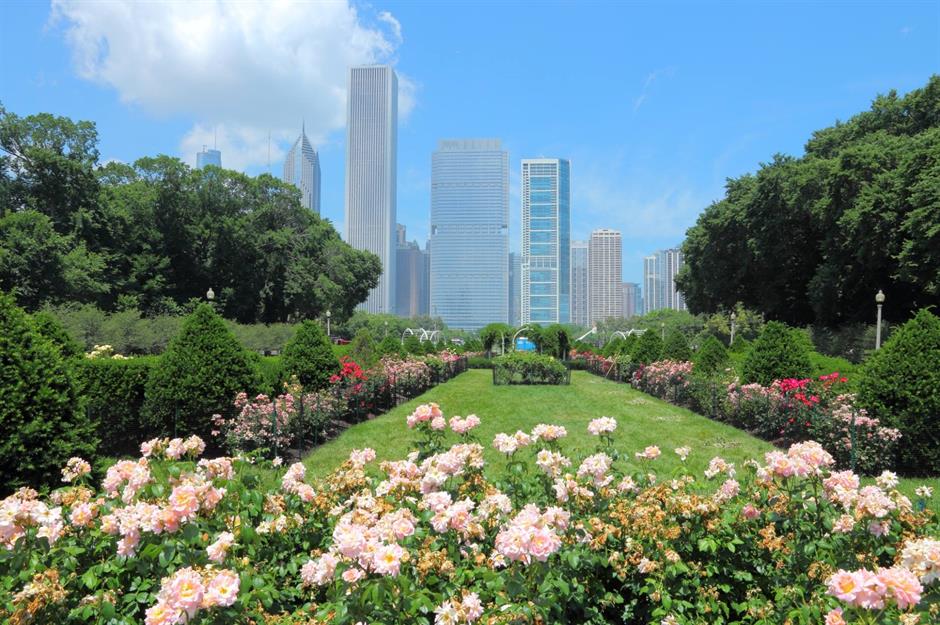
The jewel in the crown of Grant Park is Buckingham Fountain, a 150-foot-high jet of water modeled on a fountain at the Palace of Versailles. The green space, known as 'Chicago’s Front Yard,' is made up of several smaller grounds and gathering places. There’s the town square-like Millennium Park which hosts year-round outdoor events, the children’s playground Maggie Daley Park, and the Museum Campus on the south side, which contains a history museum, aquarium, and planetarium.
17. Gas Works Park, Seattle, Washington
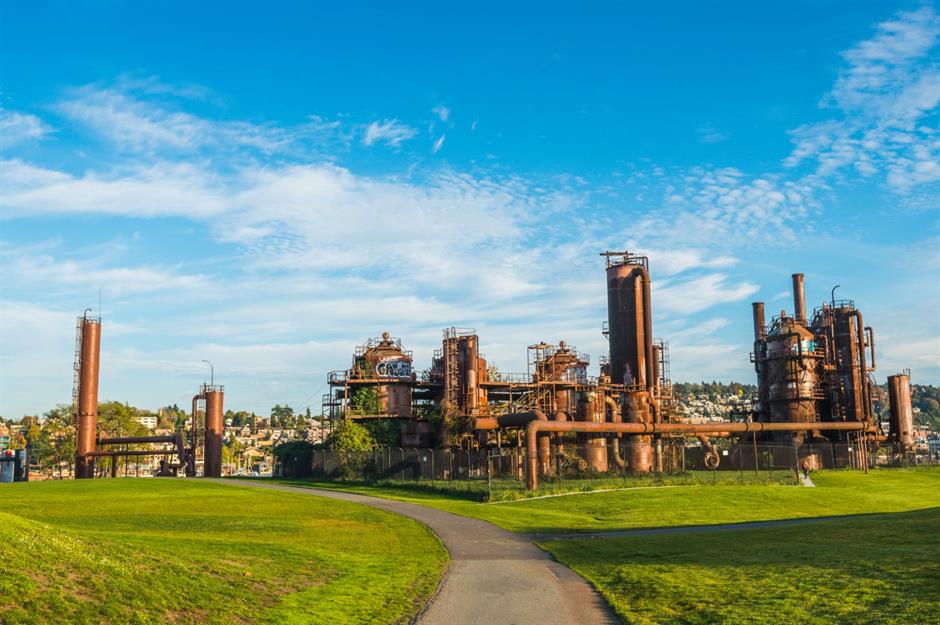
A lakeside patch of greenery with an industrial edge, Gas Works Park has been a hit with visitors and locals alike ever since it opened in 1975. As the name suggests, it’s built on the site of a former gasification plant, which closed in 1956 and was bought by the city in 1962. The man-made Great Earth Mound, built using waste materials from the plant, is the perfect spot for gazing out at the city skyline – the abandoned power plant casts a striking silhouette against sunset skies.
16. Piedmont Park, Atlanta, Georgia
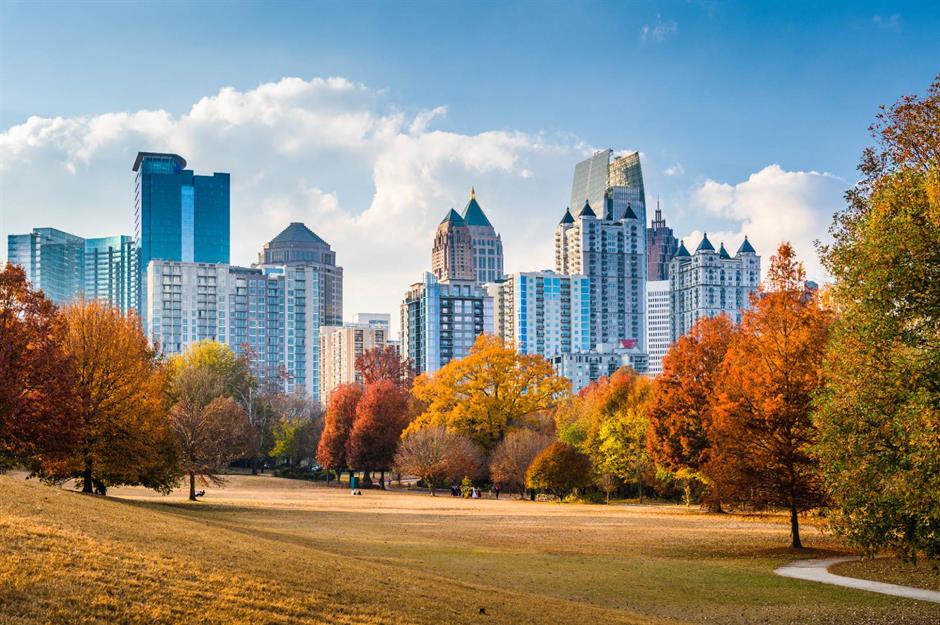
Situated in midtown Atlanta, the 211-acre Piedmont Park is a tranquil oasis in the heart of the metropolis. It’s ideal for active types, offering four to five miles of paths, a swimming pool, tennis courts, and playgrounds. There’s also a jam-packed events calendar, which includes Atlanta Pride and the Atlanta Jazz Festival, plus bucketloads of natural beauty, which is abundantly obvious in this dazzling autumnal shot.
15. City Park, Denver, Colorado

Built in 1882, the initial design for Denver’s largest park was inspired by New York’s Central Park and Prospect Park. Its creators, civil engineers Henry Meryweather and Walter Graves, designed the wide carriageways and walking paths, large grassy expanses, and panoramic vistas in their image.
Later, the Big Lake and Esplanade were added by the city’s first landscape architect, Reinhard Schuetze. Today, many of its early features remain, although there are a few newer additions including a museum, planetarium, and zoo.
14. Belle Isle Park, Detroit, Michigan

Taking a break from urban life is a little easier when you’re surrounded on all sides by water. While Belle Isle Park is connected to the mainland by the MacArthur Bridge, the 985-acre Detroit park is a world unto itself.
With ample forested areas, three lakes, and its very own beach, there’s plenty for visitors to see and do. One of the main highlights is the Anna Scripps Whitcomb Conservatory, America’s oldest continually-running conservatory, which is home to a variety of plants from all over the world.
13. Falls Park, Sioux Falls, South Dakota
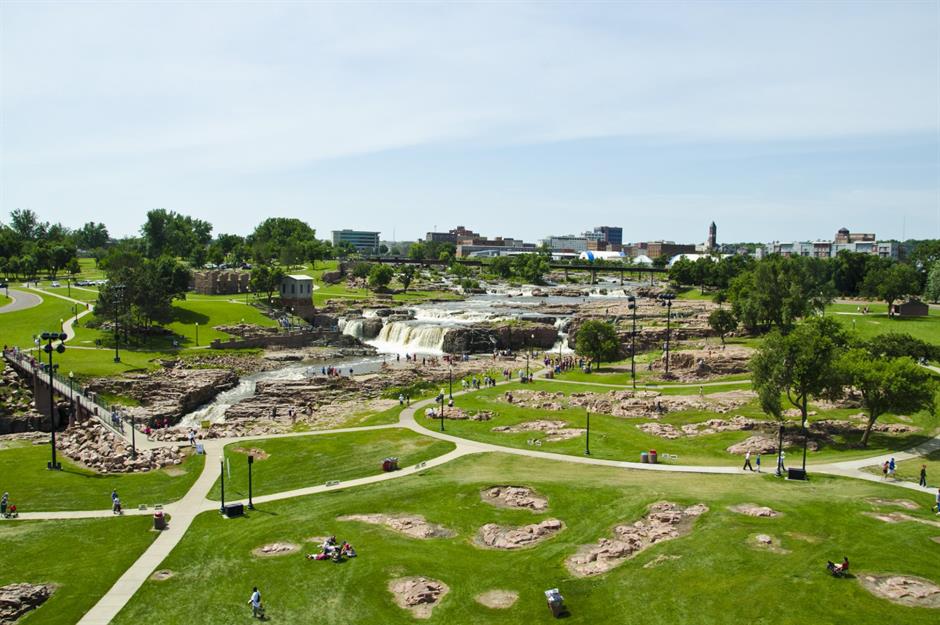
It’s not often that a city park has a waterfall running right through the middle of it. Covering 128 acres, Falls Park is home to the powerful Sioux Falls, which catapult an average of 33,600 liters of water downstream each second. Located north of the town of Sioux Falls, it also contains the remains of the 19th-century Queen Bee Mill, which was partially burned down in 1956, as well as the Sioux Falls Light and Power Company building which has been transformed into a popular café.
12. Patterson Park, Baltimore, Maryland

Before it became Baltimore’s most beloved green space, Patterson Park was the site of an important historic event. On September 12, 1814, American troops rallied on Hampstead Hill to protect Baltimore against invasion by the British.
They were successful: at the mere sight of the 20,000 soldiers, the incoming British ships were scared off and fled. Patterson Park came into being 13 years later. Hampstead Hill is now graced by a recognizable pagoda, built in 1891, which has a spiral staircase and three viewing decks for gazing out across the city. These decks are currently closed for refurbishment.
11. Red Rocks Park and Amphitheatre, Denver, Colorado
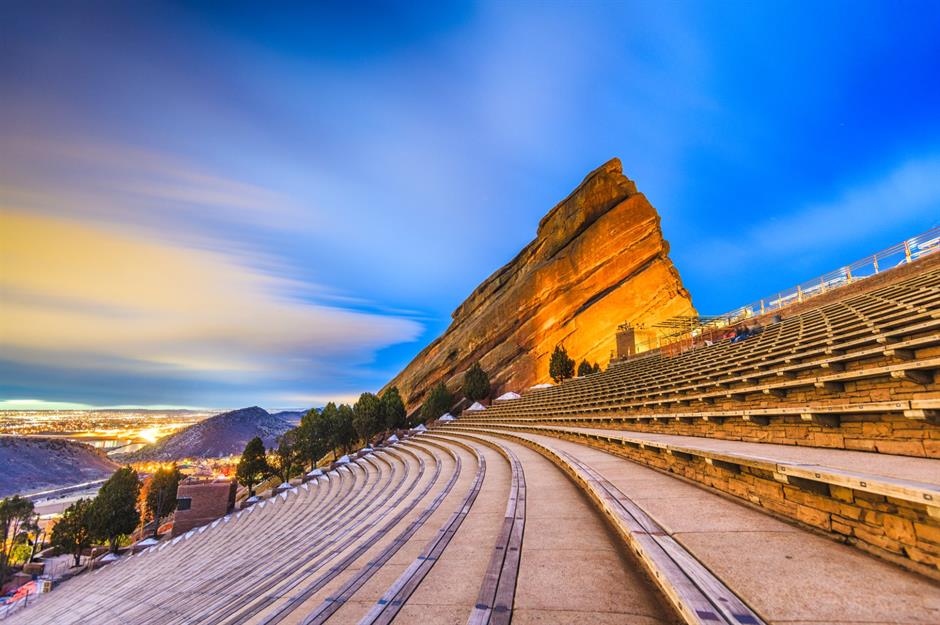
You get two attractions in one at Red Rocks: a stunning natural amphitheater and a scenic 738-acre park. With its vibrant, 300-foot-tall sandstone walls, the amphitheater is the star of the show.
Formed by the rising and falling of seas over millions of years, combined with geological uplift and erosion, the striking formation is known for its perfect acoustics, which have helped it become a top outdoor concert venue. It’s been graced by world-famous stars including the Beatles, Cher, Jimi Hendrix, the Rolling Stones, and Neil Young, to name a few.
10. Dolores Park, San Francisco, California

Offering panoramic views of downtown San Francisco, as well as wide, grassy slopes to recline against, Dolores Park seems purpose-built for gazing at sunsets like this one. Located in the Mission District, the 16-acre park has a busy arts and culture scene, with a calendar including Pride weekend events and regular film screenings. It’s also a favorite spot for active types, with tennis and basketball courts plus a variety of fitness classes held here.
9. Zilker Park, Austin, Texas

Providing 351 acres of lush greenery, Zilker Park is the place to be when the sun shines. Located in downtown Austin, just off Ladybird Lake, wealthy local philanthropist Andrew J Zilker donated the initial 35-acre patch that would later become the park, officially founded in 1934.
As well as offering plenty of natural beauty, it’s a cultural hub too. Its Zilker Hillside Theater puts on an array of productions, from Shakespeare in the Park to a summer musical, while the space is also home to the ACL Music Festival.
8. Boston Common and Public Garden, Boston, Massachusetts
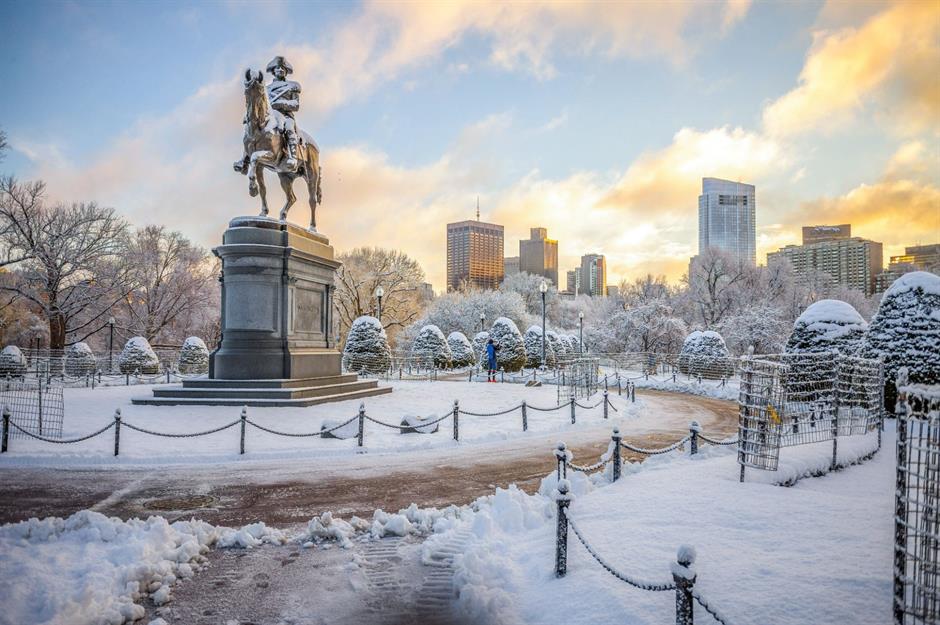
Technically two parks, Boston Common and Public Garden have strikingly different identities. The former was created in 1634, making it the oldest public park in the US. Known for its wide open spaces and practical walkways, the gathering place has hosted every revolutionary that’s come through the city, from abolitionists to civil rights activists. Martin Luther King Jr led a rally here in 1965.
Meanwhile the Public Garden, established in 1837, has a far more ornate feel with its brightly-colored flowers and trees from all over the world. It’s especially stunning in the winter, as this snow-dusted shot of the George Washington statue goes to show.
7. Forest Park, St Louis, Missouri

This stunner is at its most beautiful when the tulips come out in spring. As well as brightly-colored blooms, the 1,300-acre park wows visitors with its patchwork of forests, lakes, and streams, interlaced with more than 30 miles of walking trails. A true urban playground, Forest Park has everything from tennis, handball, and racquetball courts to an ice skating rink, bandstand, and several museums – the list goes on.
6. Papago Park, Phoenix, Arizona

The 1,500-acre Papago Park is marked out by bright red sandstone buttes, the most famous of which is Hole-in-the-Rock. As the name suggests, this distinctive outcrop is pierced all the way through with a large hole, which acts as a perfect window for panoramic views of Phoenix and the surrounding Sonoran Desert.
Prior to modern-day visitors, the Indigenous Hohokam people had been using Hole-in-the-Rock for centuries. Acting as a natural calendar, it was used to measure how the beam of light moved across the desert throughout the year in order to track the seasons.
5. Golden Gate Park, San Francisco, California

Variety is the spice of life in San Francisco’s Golden Gate Park. Within its 1,017 acres you’ll find more than 2,000 different plant and animal species, living in ecosystems as diverse as forest, wetland, grassland, and scrubland. In fact, it’s part of a larger UNESCO Biosphere Reserve, which protects endangered species for conservation and research.
On top of its unbeatable wildlife, it’s home to some great cultural and historical attractions: the California Academy of Sciences, the Victorian-era Conservatory of Flowers, and the Japanese Tea Garden, which also happens to be America’s oldest, dating to 1894.
4. Forsyth Park, Savannah, Georgia

The star attraction in Forsyth Park is a beautiful fountain, which was modeled on the Fontaine des Mers at the Place de la Concorde in Paris.
Yet despite its ornamental beauty, the fountain isn’t entirely unique. In fact, it was ordered from a catalog – the Illustrated Catalogue of Ornamental Iron Work to be precise – and installed here in 1858. Nonetheless, the 30-acre space is anything but cookie-cutter, with its breezy paths shaded by oak trees, including the legendary 300-year-old Candler Oak.
3. Balboa Park, San Diego, California

With the illuminated Botanical Building shimmering like a box of precious gemstones, Balboa Park is one of those rare parks that looks just as mesmerizing after dark. Located a short hop away from downtown San Diego, the 1,200-acre space has an impressive 18 museums, including the Japanese Friendship Garden, the Museum of Photographic Arts, and the Centro Cultural de la Raza, dedicated to showcasing Mexican, Chicano, and Indigenous art. It’s a nature lover’s dream too, with a vast array of flowers and plants to be enjoyed year-round.
2. Central Park, New York City, New York

Easily the most famous urban park in America – and arguably the world – Central Park is undeniably picturesque. However, it has a dark past. In the mid-19th century it was home to a thriving immigrant neighborhood known as Seneca Village, but when New York’s upper-class elite selected the area for a new public park, some 1,600 people were displaced.
Today, it’s hard to imagine New York’s skyline without the 843-acre patch of greenery, which is visited by around 42 million people a year. The majestic Belvedere Castle, two skating rinks, and Central Park Zoo feature on a long list of visitor attractions.
1. Griffith Park, Los Angeles, California
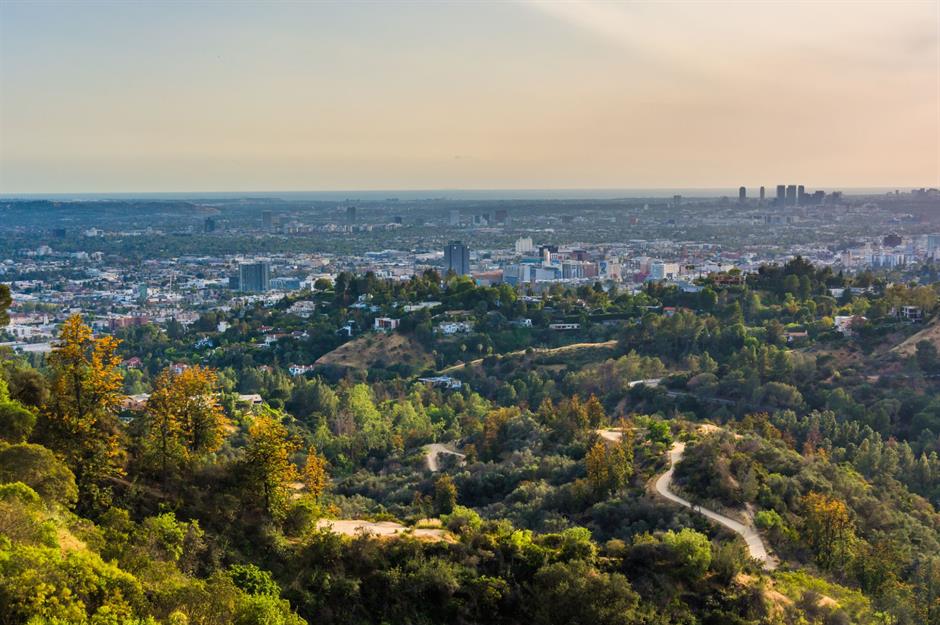
It’s a far cry from the manicured lawns we might associate with a city park, but it’s precisely this ruggedness that makes Los Angeles’ Griffith Park our pick for America's most beautiful patch of urban green. At an impressive 4,200 acres, it’s also one of America’s largest city parks.
The urban playground, located at the eastern edge of the Santa Monica Mountains, has more than 50 miles of walking trails draped across its native chaparral slopes. It’s crowned by the Griffith Observatory, which offers incredible views across LA.
These are California's most beautiful small towns and cities
Comments
Be the first to comment
Do you want to comment on this article? You need to be signed in for this feature